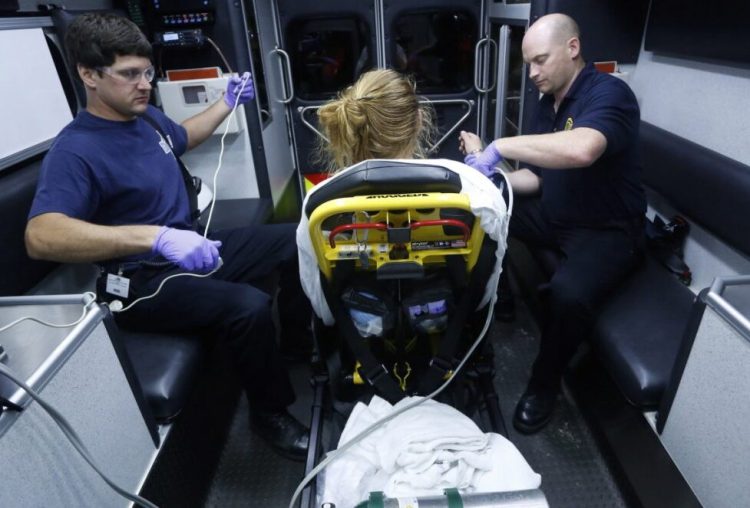AUGUSTA — Drug overdose deaths in Maine appear to be on the rise again after a slight decline in 2018, highlighting the continuing challenge Maine faces in combating the opioid addiction epidemic.

A report Thursday from the state Medical Examiner’s Office said that 277 Mainers lost their lives to drug overdoses in the first nine months of 2019. Data for the entire year are not yet available, but the current death rate puts Maine on track for 369 fatal overdoses in 2019, a 4 percent increase from the 354 deaths in 2018.
Gordon Smith, whom Gov. Janet Mills appointed as Maine’s director of opioid response last February, said the latest numbers were disappointing and discouraging, especially after a 15 percent decline in overdose deaths from 2017 to 2018.
“It just seems to me in the state of Maine, we ought not to have almost 400 people dying a year, it just seems shameful, but we are doing all we can,” Smith said.
Nationally, overdose deaths rose by 9.6 percent from 2016 to 2017, according to the most recent data available from the federal Centers for Disease Control and Prevention. In 2017, 47,600 people died from opioid-related overdoses, representing 67.8 percent of all overdose deaths in the nation.
Smith said his office has been working hard to address the drug crisis, but many of its efforts were not fully implemented until after the nine-month overdose reporting period ended in September. A new program that aims at prevention, including a new curriculum for all Maine public schools being created by the Department of Education, will be available in September.
Smith is optimistic the numbers for 2020 will be better. “They’ve got to be,” he said. Maine overdose deaths hit their highest level in 2017, when 417 people died.
“I am concerned that the number of deaths resulting from overdoses remains high,” Maine Attorney General Aaron Frey, whose office released the data, said in a prepared statement. “The data in this report confirms how significant this crisis is. It will take dedication from elected officials, individuals, organizations and communities across the state to get to the other side of this, and I am strongly supportive of the efforts underway to turn the tide.”
The vast majority of the deaths, 246, were classified as accidental. There were 27 classified as suicides and four had an undetermined manner of death. Opioids were listed as a key factor in 84 percent of the deaths.
The state’s counties with the largest populations – Cumberland, York, Androscoggin, Penobscot and Kennebec – also saw the largest number of deaths.
The report also shows that 229 of the deaths, or 82 percent, were attributed to two or more drugs, while 16 percent, or 44 cases, involved one drug.
Smith said efforts to provide broader access to the opioid overdose antidote naloxone and expand needle exchange programs were just going into full swing. But he pointed to gaps in Maine’s response to the crisis, including a lack of recovery coaches and recovery houses to complement the availability of medication-assisted treatment.
The uptick in deaths was alarming for some political leaders at the State House, who have supported providing more resources to respond to the crisis.
“This is absolutely devastating news,” House Speaker Sara Gideon, D-Freeport, said in a prepared statement. “This data represents more than numbers – it represents our family, our friends, our neighbors. In every instance, at every age, and in every corner of our state, we should be doing everything in our power to save every life possible.”
Bob Fowler, the executive director of Milestone Recovery in Portland, which treats patients with substance use disorders, said the increase in overdose deaths was disappointing but reflects what he described as the third wave of the opioid crisis. The first involved prescription drugs, and later street drugs like heroin, but the threat now lies in powerful synthetic opioid analogues, such as fentanyl.
Fowler said long wait times for those seeking placement in a residential recovery treatment program present a critical gap in Maine’s response. But he pointed to the value of Medicaid expansion in providing access to treatment. He and Smith both said Maine has made steady progress in reducing the stigma associated with substance use disorders and corresponding treatment.
“If there is a silver lining in it, it’s that it will remind people that this took 25 years to get here and there is no silver bullet and there is no easy way out of this and it is going to take a long time and unfortunately people will have to be patient and you have to do a lot of things right,” Smith said.
He said that included focusing more resources on prevention, harm reduction, and treatment and recovery. Mills has made responding to the state’s overdose crisis a priority for her administration.
Earlier this month, Smith detailed for the Legislature’s Health and Human Services Committee how his office was using state and federal grant money to expand needle exchanges, develop prevention curriculum for public schools and more widely distribute naloxone to first responders, including police. Jail and prison-based medication assisted treatment programs also were expanded, as were programs offered by hospital emergency rooms to help people find treatment.
“What we are now seeing is a capacity issue in the treatment system,” Fowler said. “We need to be able to have open doors available to people when they are ready to walk through them.”
Fowler said “easy and ready” access to all levels of care was critical to getting ahead in saving lives. “We really just need more everything,” he said.
“What the (new) numbers say to me is we have made some progress and we still have a long way to go,” he said.
Send questions/comments to the editors.




Comments are no longer available on this story